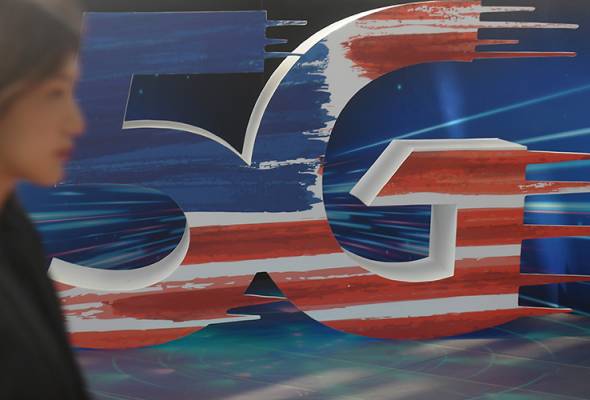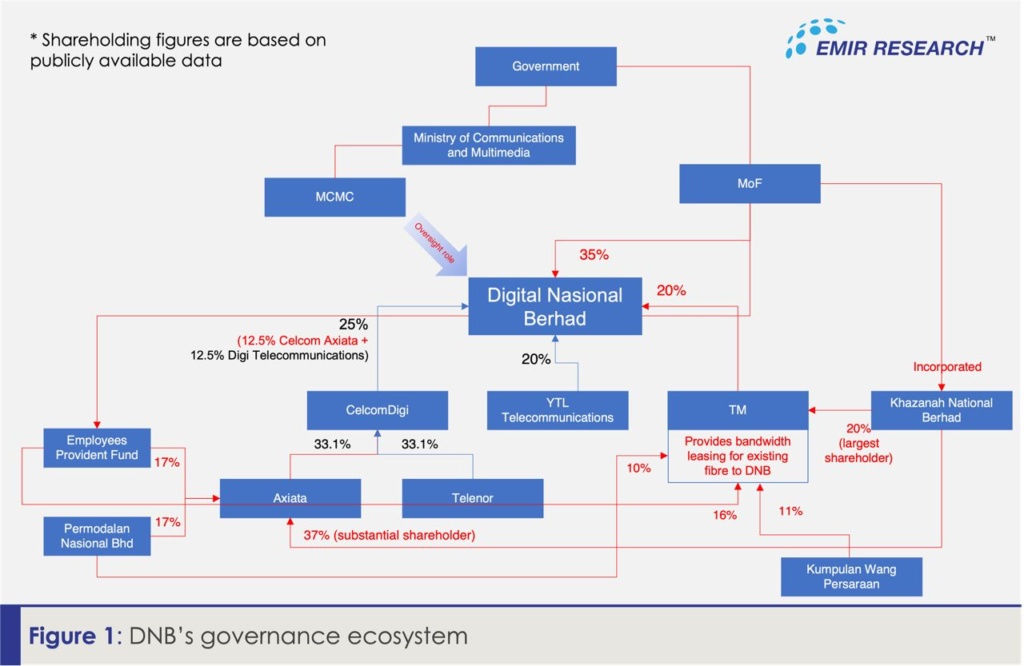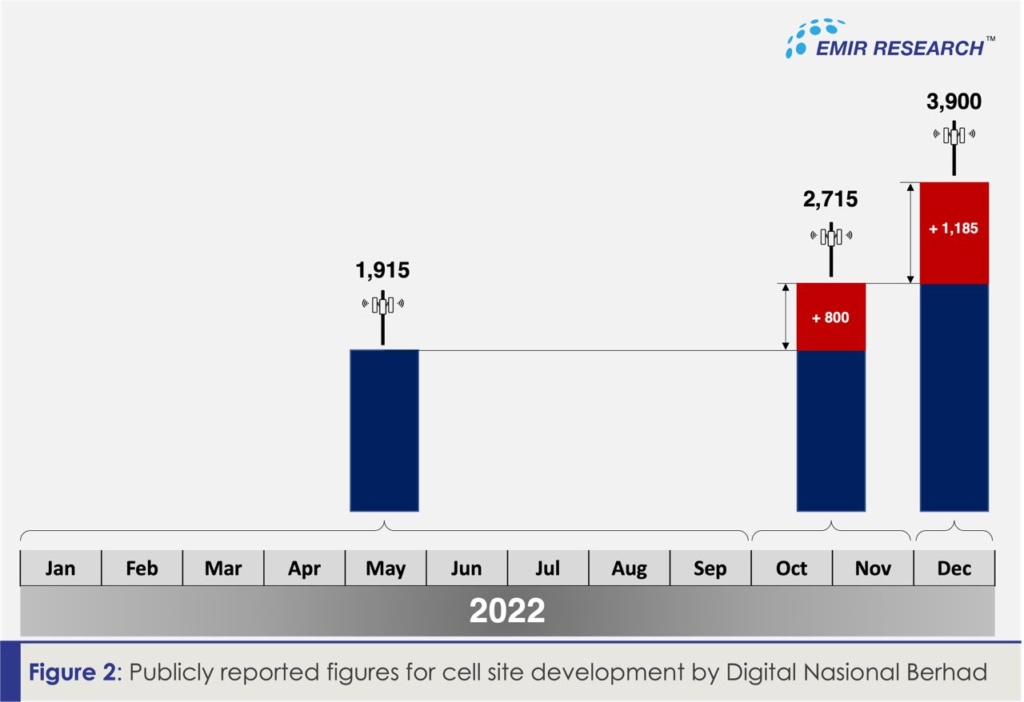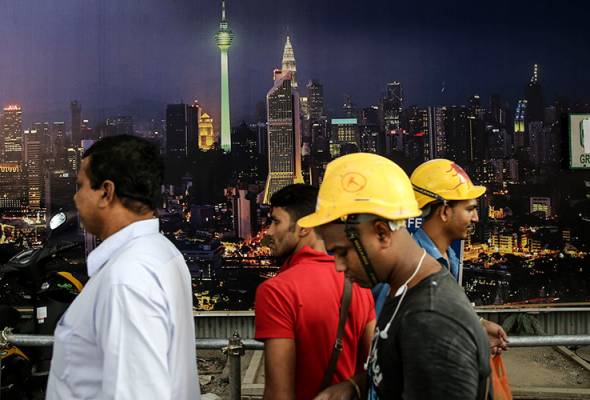
Published in MYsinchew, AstroAwani & Malaysiakini, image by AstroAwani.
In light of the ongoing revision of contentious DNB’s 5G rollout model, for the benefit of the decision-makers and public, EMIR Research continues to revisit some of the cornerstone aspects of the debate, which, to date, DNB has failed to address in a credible and fully transparent manner.
In the previous article, we tried to decipher DNB’s misleading claims, albeit through their paid consulting UK-based company Plums Consulting (for a most recent example, refer to “An analysis of EMIR’s “Reviewing contentious DNB’s 5G””), about their ability to provide lower costs to the end customers (refer to “Malaysian 5G Rollout: Camouflaged Costing Acrobatics” for details). But, whenever there are camouflaged costing acrobatics, there are simply bound to be serious governance red flags.
DNB’s response to the public criticism of its highly vulnerable governance ecosystem, so far, has not gone further than assuring its “proper governance” is ascertained by the existence of the Board of Directors (BoD), close (even “minute by minute, transaction by transaction”) scrutiny and extensive regulation by Malaysian Communications and Multimedia Commission (MCMC), an “independent” regulator; and “constant gaze and review of its highly critical, expert and informed wholesale [customers-investors]”.
Figure 1 is an embodiment of how, sometimes, a picture is worth a thousand words. The figure illustrates the true worth of claims by DNB, the government-led entity with a government-linked oversight ecosystem and beneficiaries, of its constant independent oversight and critical review.

1MDB also had a BoD with very big names. Has anyone of that BoD been persecuted for not fulfilling their fiduciary responsibilities and duties? The climate of impunity has been flourishing in Malaysia for some time now.
1MDB also had a set of “independent” auditors, regulators and other governance ecosystem actors to monitor and scrutinise 1MBD. Nevertheless, we all saw what had happened.
As for DNB, do note that MCMC is an agency under the Ministry of Communications and Multimedia, thus representing the government and not a truly “neutral” entity under DNB’s overall “government-led” model.
And, speaking of regulators, one of the principles of good governance states not to appoint former officials of regulatory agencies to the BoD or senior management team in a similar industry due to the potential of exerting influence over decision-making by the regulators who ought to be independent. We saw this as a big problem when former US FDA (Food and Drug Administration) senior officers were appointed by big pharmaceutical companies like Pfizer to advance their corporate objectives, not necessarily in the nation’s and people’s best interest.
Nevertheless, in the gross violation of this vital principle, Dato’ Mohamed Sharil Tarmizi, former Chairman and Chief Executive of the MCMC, is appointed as (attention!) Chairman of Board Tender Committee for DNB. This is despite his 11 years (in total) of service in MCMC in key positions (senior officer during MCMC’s formative years 2000-2006, Chief Operating Officer during 2009-2011 and Chairman and Chief Executive during 2011-2014).
And DNB appears to hide behind MCMC a lot to justify its viability, “progress”, etc., with still no publicly available verified data to adjudge their viability or progress credibly.
In fact, it is beginning to already publicly look more and more that it is DNB that sets the tone for what MCMC have to comply with and not vice-versa.
For example, DNB has been forcing Malaysia’s major telcos into its access agreement throughout the entire year 2022 with an eternally revolving deadline (from 30 June 2022 to 8 July 2022, to 31 August 2022, to 30 September 2022, to 30 October 2022) despite the absence of regulatory framework by MCMC for the 5G Access Agreement covering areas like Service Level Agreement (SLA), pricing etc. which was supposed to be ready only in December 2022. Sign first, framework later. Audacity of Impunity!
The situation around DNB’s discretionary-reported, unverified by regulator 5G rollout “progress” is even more impudent, causing fair reprimand by the Communications and Digital Minister.
According to Jendela Q3 2022 Report, as of 30 September 2022, DNB has completed 1,915 sites (54.4%) out of the planned 3,518 sites for 2022 while significantly underperforming for the third quarter.
During the press conference held on 7 December 2022, Communications and Digital Minister shared that DNB has deployed 2,715 5G cell sites as of 31 October 2022 with 36% 5G population coverage.
However, already on 12 December 2022, DNB reported on its website that “its 5G network is ahead of schedule” and “will exceed 40% coverage of populated areas nationwide by December 2022”, while on 2 January 2022, an arbitrary post appears informing that DNB “has achieved almost 50% coverage of populated areas (COPA) with some 3,900 sites as at end-2022”.
To present it graphically (Figure 2), in the last three months alone, DNB has built as many cell sites as in the previous nine months, but the latest figure is not verified by MCMC, according to the Minister. And, despite this firm reprimand by the Minister, DNB still has not pulled down this information from their website—the climate of impunity.

Nevertheless, if this is true that DNB is on schedule (or even “ahead of it”) by the end of 2022, as it claims, despite significantly lower numbers reported by officials as of the end of October, more serious questions arise — how is the audit being done? Are the sites counted actually ready for service and of acceptable quality (built, cleaned of installation defects, running on permanent rather than temporary equipment—such as Genset and using microwave links, accepted into network operations, optimised and handed over from Ericsson to DNB)? Is there a performance criterion set by MCMC for DNB to fulfil, such as, for example, transmission speed? When a base station is commissioned, do we have test results? Was test acceptance done? Was it documented?
After all, MCMC had its own challenges in providing proper oversight for the previous generation networks. A “minute by minute, transaction by transaction” regulation, as claimed by DNB, is simply a humourless joke.
Furthermore, let’s not forget the timely CelcomDigi coming on board of DNB as an equity-holder and service subscriber after months and months of resistance under the previous leadership of Datuk Izzaddin Idris (personally groomed and selected as successor by the previous highly respected CEO of Axiata group).
However, after the surprising (or maybe not surprising, keeping Figure 1 in mind) resignation of Datuk Izzaddin Idris from his position as Axiata president and group CEO and Celcom chairman effective 31 May 31 2022, and the appointment of two foreign nationals as acting CEOs effective 1 June 2022 and again former twice chairman of MCMC as DNB’s interim Chairman effective 2 June 2022 things in Celcom have started to move smoothly for DNB.
But here comes another question. Is that sudden jump in cell sites by DNB that we observe not due to existing infrastructure sharing with the CelcomDigi? Is this not the reason why the cell site construction boost by DNB also coincides with the redirection of its deployment efforts to other states, which were initially intended for 2023 and beyond?
We already know that infrastructure sharing would be done by telcos even in the absence of DNB (refer to “Malaysian 5G Rollout: Camouflaged Costing Acrobatics”). However, in the context of this discussion, this is a critical governance issue that needs to be clarified. After all, the cell sites publicly counted by DNB in its reports are budgeted under their claimed costs and financed by sukuk guaranteed by the government or, simply put, people’s money.
Clearly, with all the above, the public should be very worried, especially given that Malaysia is still struggling to repay the enormous debts incurred in the 1MDB scam, the biggest kleptocracy case in the history of the US and possibly the world.
Maybe it is time for the DNB‘s CEO, Board and other officials to appear in front of the Parliament select committee to explain what is really going on. Before it is too late.
The climate of arrogated impunity must end in Malaysia. Perhaps this is the start. Audacity of Hope for the nation and the people.
Dr Rais Hussin is the president and chief executive officer of EMIR Research, a think tank focused on strategic policy recommendations based on rigorous research.

